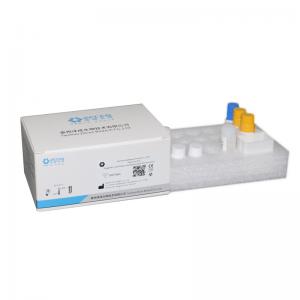

Add to Cart
CLIA Reagents of Inflammation (HA)
【Expected usage】
This product is used to quantitatively detect the content of
hyaluronic acid (HA) in human serum in vitro.
Hyaluronic acid (HA) is a linear polymer polysaccharide composed of
glucuronic acid and N-acetylglucosamine disaccharide units as
monomers. Physiological function of receptor action to play its
important role. HA molecules are synthesized by interstitial cells
in various tissues, enter the blood through lymphatic pathways, and
are taken up and degraded by liver endothelial cells. Elevated HA
in blood.
Especially in judging the severity of liver disease, identifying the presence or absence of liver cirrhosis and predicting its development trend, HA is a good serological indicator. Among the early indicators reflecting liver fibrosis during the transformation of chronic liver disease to cirrhosis, HA has the best diagnostic value.
The diagnosis of liver fibrosis has always depended on the
pathological diagnosis of liver biopsy, which has many obvious
deficiencies, such as trauma, difficulty in repeated biopsy, and
certain complications (1/3 of patients have pain; 0.3% of Serious
complications in patients including hemorrhage, pneumothorax, colon
and gallbladder perforation; and 0.03% mortality), non-uniformity
of lesions within the liver, intra- and inter-observer variability,
insufficient specimen length (length <20mm and <10 portal
areas) are prone to underestimation and specimen fragmentation and
subcapsular fibrosis can cause artifacts. For many years, people
have been trying to find non-invasive serological indicators to
evaluate liver fibrosis in chronic liver disease, including routine
biochemistry, fibrosis, cytokines, immune function, etc., but so
far, no single indicator can be sensitive enough and accurate
enough reflect the degree of liver fibrosis.
According to the survey, liver cirrhosis occupies the sixth leading
cause of death in the world. At present, there are 120 million
hepatitis B virus carriers in my country, and about 35 million
chronic hepatitis B patients. Together with chronic hepatitis C,
fatty liver, schistosomiasis, immune liver disease, etc. Large
potential patient population with liver fibrosis. Liver fibrosis is
an inevitable stage in the development of liver cirrhosis. Liver
injury caused by various factors can be secondary to liver fibrosis
and then develop into liver cirrhosis. Early detection and active
treatment of liver fibrosis, to reverse or delay its development,
play a very important role in improving the quality of life of
patients and improving the prognosis of patients.
There are many serological indicators for liver fibrosis detection.
At present, the combined detection of hyaluronic acid, laminin,
type III procollagen N-terminal peptide and type IV collagen is
used to diagnose liver fibrosis. Among them, HA is also known as
"small liver penetration", and the measurement has the following
functions: 1. It reflects the formation of liver fibrosis; 2. It
reflects the degree of liver fibrosis; 3. It reflects the function
of liver cells; 4. It reflects the inflammatory lesions of the
liver; It is an asymptomatic viral infection or severe viral
infection, alcoholic liver disease, and biliary cirrhosis. As far
as the current clinical research is concerned: HA is the most
sensitive and specific index (more than 80%) among many fibrosis
biochemical indicators.
HA is a good serological indicator for judging the severity of
liver disease, identifying the presence or absence of liver
cirrhosis and predicting its development trend; at the same time,
HA is also the most valuable indicator of liver fibrosis in the
early reflection of the transformation process of chronic liver
disease to liver cirrhosis.
At present, the four domestically recognized indicators, namely HA, LN, PIIINP, and CIV, have a sensitivity of 60-70% and a specificity of over 90% for the diagnosis of liver fibrosis. Therefore, it provides a convenient and quick monitoring method for early clinical diagnosis and early treatment of patients.
Hyaluronic acid is currently measured in clinical and laboratory
methods including enzyme-linked immunosorbent assay, colloidal gold
method, fluorescence immunoassay, and chemiluminescence method.
| Test Item | HA |
| Luminescent Principle | Enzymatic chemiluminescence |
| Luminescent Markers | AP(alkaline phosphatase) |
| Specification | 100 Test/Kit for CIA series |
| / | |
| Principle | Sandwich method |
| Component | Magnetic Beads |
| Calibrator Low | |
| Calibrator High | |
| Anti-A/Anti-B | |
| Control 1 | |
| Control 2 | |
| Accessories Required But Not Provided | Substrate |
| Washing solution | |
| Sample material | Serum |
| Storage | 2-8℃ |
